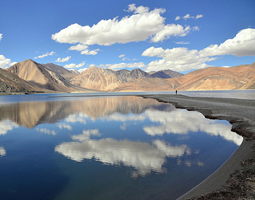
The Mystical Land Barren and Beautiful
Ladakh is a land like no other. Bounded by two of the world's mightiest mountain ranges, the Great Himalaya and the karakoram, "land of high passes" is a region of Jammu and Kashmir, the northernmost state of the Republic of India. It lies between the Kunlun mountain range in the north and the main Great Himalayas to the south, inhabited by people of Indo-Aryan and Tibetan descent. Ladakh is renowned for its remote mountain beauty and culture. It is sometimes called "Little Tibet" as it has been strongly influenced by Tibetan culture. The Ladakh range and the Zanskar range, Geologically this is a young land, formed only a few million years ago by the backling and folding of the earth's crust as the Indian sub -continent pushed with irresistible force against the immovable mass of Asia.
Ladakh lies at altitudes ranging from about 9,000 feet at Kargil to 25,170 feet at Saser Kangri in the Karakoram. Thus summer temperatures rarely exceed about 27 degree in the shade, while in winter they may plummet to minus 20 degree even in Leh. Surprisingly though, the thin air makes the heat of the sun even more intense than at lower altitude.
Ladakh known by many names like the Red land,,Snow Land,Land of the Lamas,Little Tibet,Heaven of Monasteries is known for its rugged terrains,barren lands,snow capped mountains,cultural heritage,heavenly monasteries,natural landscapes,with virgin valleys and rivers….. it is said that only in Ladakh can a man sitting in the sun with his feet in the shade suffer from sunstroke and frostbite at the same time.
MUST SEE: Hundar a village in Nubra one can visit the king’s palace and Temple of Buddha. Diskit famous for sulphur springs and monasteries.
MUST DO: Take the famous bactarian camel ride in Hundar.
MUST REMEMBER: An innerline permit is required to visit Nubra valley
MUST SEE: Pangong in its diverse colours.
MUST DO: Camp here and watch the starry sky.
MUST REMEMBER: An innerline permit is required to visit Pangong lake.
MUST SEE: A great place for bird watching and wild animals.
MUST DO: Have Maggi Noddles and sip tea in one of the tea stalls. Camp at Lake tso-moriri and watch the lake change its colours.
MUST REMEMBER: An innerline permit is required to visit Tso-Moriri.
You can enjoy shopping for curios and souvenirs in the bazaars and markets of Leh, while on your tour of Ladakh. Popular items with tourists are Pashmina shawls, stoles and other Pashmina wool garments. Locally handmade woolen socks, gloves, caps and sweaters are a favorite of tourists in Ladakh. Tibetan handicraft items including prayer wheels, Buddhist masks and Thangka paintings can be purchased in Ladakh. Tibetan silver jewelry and traditional Ladakhi jewelry with turquoise are also popular with tourists. Apricots that grow abundantly in Ladakh are another popular gift that you can take back as a delicious souvenir of your trip to Ladakh. Handwoven rugs, carpets and shawls are available in a range of prices in Ladakh's markets. The carpets have floral or geometric designs or dragon motifs on them and can also be hung as decorative wall hangings. Woven in wool gathered from Ladakhi goats, and dyed with natural dyes, Ladakhi carpets and rugs are thick, long-lasting and objects of utility and beauty, which you can buy while shopping in Ladakh. While shopping in open markets, bargaining is commonly practiced and the final price you pay for any product will depend on your skill at negotiating with the seller. In government-run crafts emporia and larger established stores the prices are fixed and bargaining does not occur.

We at Paradise and Beyond take immense pleasure in introducing ourselves as Registered Travel agents catering to tourism for the very beautiful state of JAMMU AND KASHMIR.Welcoming all the esteemed travel agencies and customers from all over India and abroad to use our safe, pleasant & reliable services.
Copyright © 2015 Echelon. All Rights Reserved | Design by Echelon